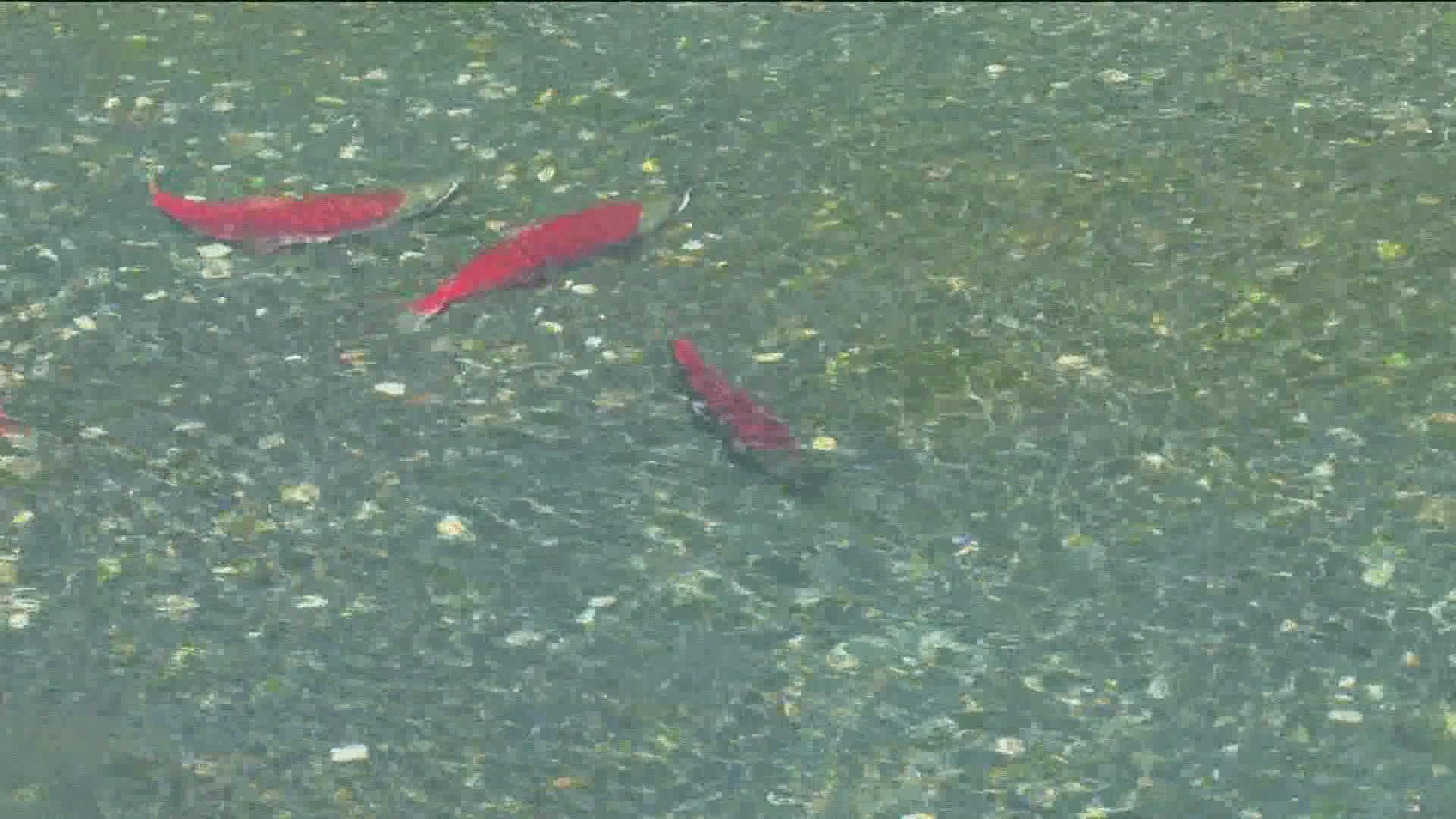BOISE, Idaho — More imperiled Snake River sockeye salmon returned to central Idaho this year than in nearly a decade, but biologists are disappointed that few of them came from fish that spawned naturally in the wild.
The Idaho Department of Fish and Game said Wednesday that 736 adult sockeye salmon completed the 900-mile (1,450-kilometer) trip from the Pacific Ocean to the high-elevation Stanley Basin at about 6,000 feet (1,800 meters). But only 46 came from adult fish that spawned naturally in Redfish Lake.
The population is bolstered with a complex hatchery program that tracks the genetics of individual fish with the goal of one day getting a naturally reproducing, self-sustaining sockeye salmon population in Idaho. That would take multiple years of more than 1,000 naturally spawned fish returning.
“There weren’t very many juveniles that went out (in 2020), and they went into a fairly poor ocean,” said Dave Venditti, a research biologist who oversees Fish and Game's Snake River Captive Brood Stock Program. “Hopefully, the ocean is turning around, and smolts (young fish) that went out this year and the next couple of years will see better ocean conditions. That’s the real driver of these natural returns.”
Young sockeye salmon, both hatchery and naturally reproduced fish, leave the Stanley basin in spring. Most fish spend two years in the ocean, though some stay only one year and others three, before starting the return trip to Idaho past eight dams on the Columbia and Snake rivers. Most Snake River sockeye salmon weigh about 7.5 pounds (3.4 kilograms).
An estimated 150,000 sockeye at one time returned annually to the lakes near the town of Stanley. Redfish Lake was named for the abundant red-colored salmon that spawned there. Federal officials say the run declined starting in the early 1900s because of overfishing, irrigation diversions, dams and poisoning,
Snake River sockeye salmon were listed as endangered under the Endangered Species Act in 1991 when they teetered on the brink of extinction. An elaborate hatchery program was started that decade to save the species. From 1993 to 1999, less than 10 fish made it back to Idaho each year.
Returns peaked in 2014 with 1,513 fish but collapsed the following year when a heat wave raised river temperature to lethal levels, killing most sockeye salmon. Fish and Game collected only 91 fish.
Returns have mostly been below 200 since then, with a low of 17 in 2019, making 736 a comparatively good number. A few more stragglers could show up in the Stanley basin in the coming weeks, Venditti said.
Of the 736 returning fish, some were sent to hatcheries to be spawned, and 467 were released into Redfish Lake to spawn naturally along with about 750 hatchery-raised adult fish put into the lake. Those fish were raised at the Idaho Department of Fish and Game's Eagle Fish Hatchery in southwestern Idaho and NOAA Fisheries’ Manchester Research Station in Port Orchard, Washington. Another 102 adult hatchery fish raised at the Manchester facility were released into Pettit Lake, not far from Redfish Lake.
In all, that's more than 1,300 adult fish released into the two lakes to spawn, the most since 2014 when Fish and Game released 2,073 adult sockeye salmon. The 1,300 ranks fifth highest in adult releases into the lakes going back to 1993.
The adults typically spawn in October and November, putting eggs on the lakebed that hatch in February and March. The young fish live in the lakes for one or two years before heading for the ocean.
Snake River sockeye salmon live at the edge of the species' range. It's the most southern population of sockeye salmon, travels the farthest inland of any sockeye salmon population, and spawns at the highest altitude of any population. The fish don't eat once they enter freshwater, where they spend months traveling before spawning.
“I think it's an astounding achievement of biology,” Venditti said, like many impressed that a fish weighing about 7.5 pounds (3.4 kilograms) can make the journey from the ocean to a mountain-ringed central Idaho valley. “The simple answer is they've evolved to do it. It's kind of a mystery. To me, it's just fantastic.”
About 1,900 sockeye salmon made it last summer past the last of the eight dams to Idaho, but only 736 survived the rest of the way as of Wednesday. Venditti said those that didn't make it likely ran out of reserves as water warmed as summer progressed, speeding up the cold-blooded fish's metabolism and using up their store of energy.
Watch more Local News:
See the latest news from around the Treasure Valley and the Gem State in our YouTube playlist:

